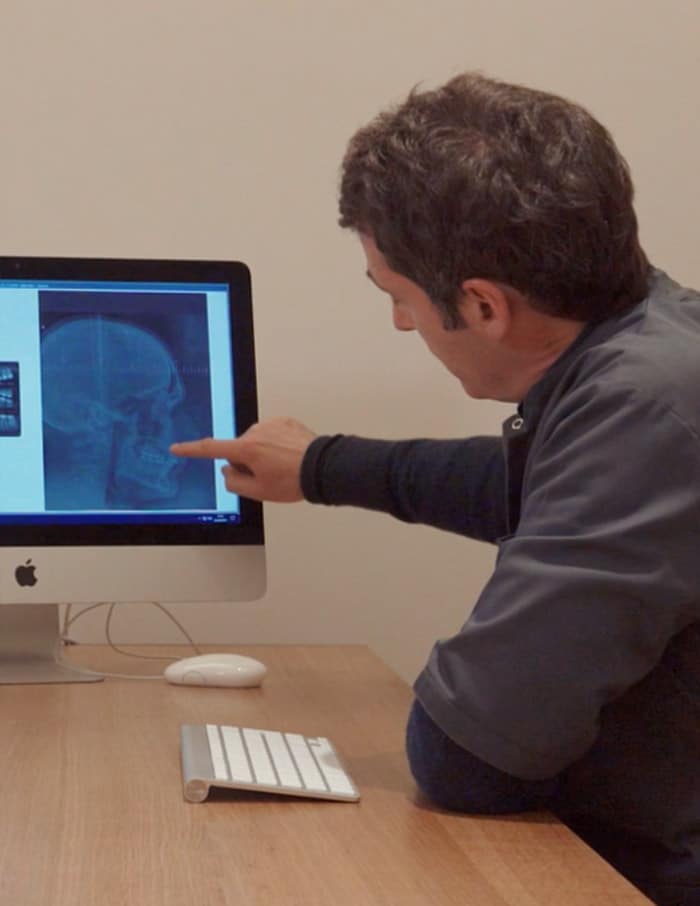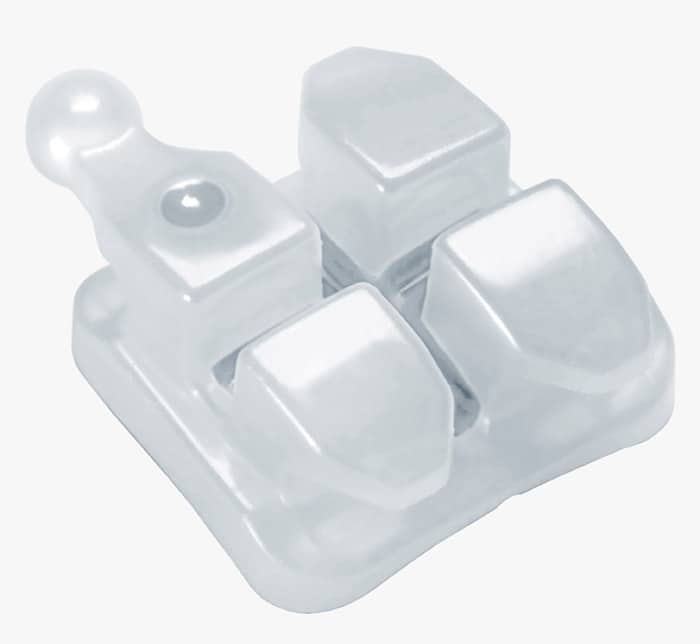Ceramic Orthodontics
by Dr. Issembert
Dr. Issembert’s introductory remarks
For the sake of the organization of the site, I have decided to write a chapter on the particularities of children’s orthodontics and therefore on early orthodontics, but you should keep in mind that braces are not reserved for children, just as Invisalign and lingual braces are not reserved for adults.
It would simply have been redundant to explain the specifics of children’s orthodontics in each section of the “search bar” and the logic of the site would have been lost if “children’s orthodontics” had been a section of the site along with lingual orthodontics and Invisalign.
What is orthodontics with ceramic braces?
Orthodontics with ceramic braces refers to an orthodontic technique with white ceramic external attachments. At Dr. Issembert’s Orthodontic Office, we also use white wires, so that the treatment is as discreet as possible. This technique has the following advantages:
The devices are very discreet. In contrast to external metal braces, ceramic braces with white wire can go completely unnoticed in most situations. This allows patients, whether children or adults, to continue their daily activities without any constraints, discomfort or derogatory remarks. This is an essential element in both private and professional life.
This is a less expensive technique than lingual braces. The so-called mixed lingual technique, which combines external ceramic bands with white wire at the bottom and lingual bands at the top, can also be an interesting alternative, a little more expensive but even more discreet.
3.
It is a technique that can be used in 100% of cases, both in adults and children. Ceramic band treatments with white wire are similar in every way to traditional external band treatments, and are therefore feasible in all types of situations and at all ages.
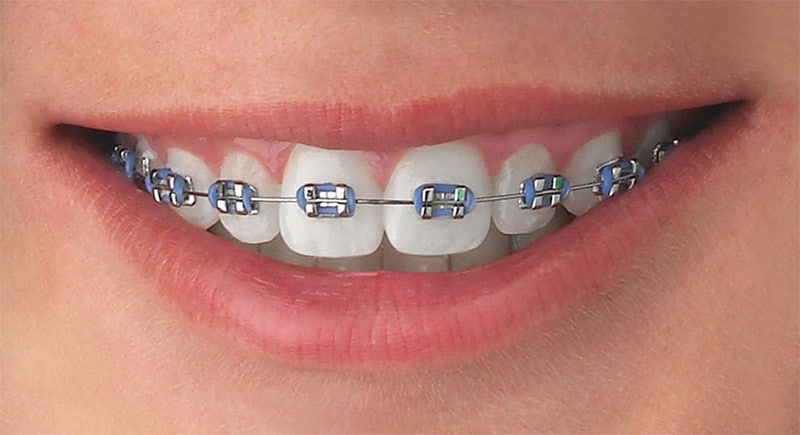
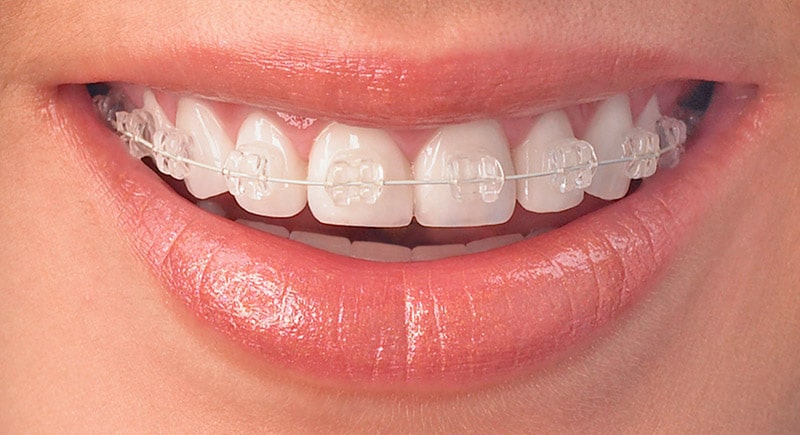
We also offer our patients a “mixed lingual” orthodontic treatment, which combines lingual braces on top with external ceramic braces on the bottom. This treatment is a little more expensive, but is even more discreet, since the ceramic bands and the white wire are largely hidden by the lower lip.
- The braces are bonded to the teeth, allowing them to grip the teeth.
- Orthodontic wires are the active element. They are usually shaped like a parabola, which corresponds to the shape of the dental arch.
This first phase, called preliminary alignment, usually requires passing wires of increasing size because the first wire does not exert sufficient force to complete the pre-alignment. It is not possible to pass the largest wire directly, as it would be too rigid to be inserted into the brackets of the teeth furthest from the final position. In addition, the parasitic effects of the desired movements are proportional to the forces exerted by the wires. Therefore, the first wires must generally be not very rigid, and therefore of small size.
(NB: this description is very simplified. These are general principles. It is obvious that there are many situations where the orthodontist will go beyond the basic protocol to carry out his treatment – use of accessories, teeth not covered by the first wire…).

These rigid wires of the intermediate phases have several essential roles:
- They can be used as a RAIL: the rigid wire is the equivalent of a railroad track on which we can slide the teeth. In cases of tooth extraction or gaps between teeth, we slide the teeth bordering the edentulous areas onto these wires. This is how we close the spaces.
- They can be used as ANCHORING: the rigid wire will also be used with elastics between the two jaws. Indeed, being rigid, it allows to solidify all the teeth of the same arch and thus to reduce the parasitic effects of the elastics.
- They can be used to modify the arch forms: often the soft wires at the beginning of the treatment pre-align the teeth but the arch forms remain imperfect (too pointed, too narrow, too wide, impossible to coordinate with the antagonist arch). Moreover, since they are not permanently deformable because they have a shape memory, they must be replaced by these famous rigid wires made of steel or other rigid alloys so that the orthodontist can establish the arch form.
In the final phases of treatment, finishing protocols vary greatly but are always based on wires and brackets or even elastics between the jaws.
The Ceramic technique by Issembert
Dr. David Issembert has 17 years of expertise in orthodontics with ceramic braces, and treats several hundred patients per year with this technique. As with the other techniques he uses, he has developed his own expertise, which allows him to treat the most complex cases by combining aesthetic requirements during treatment with the effectiveness of the movements and the stability of the results in the long term.
Orthodontic treatments with ceramic braces by Issembert all include double retention at the end of the treatment, which is included in the price of the treatment. The double retention, if respected, is the guarantee of a stable treatment over time.

AESTHETIC REQUIREMENT
Treatment Aesthetics:
- • Ceramic rings with white thread, very discreet when smiling
- Change of ligatures at each visit, as they can turn yellow if the food intake is very spicy
- Food and hygiene instructions to maintain the translucency of the elastics that hold the wire in the bands. The ceramic rings themselves cannot be colored
Aesthetics of the result:
- Search for an optimized smile curve, a maximum of symmetry, an alignment without compromise, an absence of loss of lip support, a maintenance or obtaining of a maximum of width, an aesthetic relationship of the upper lip with the lower lip (hemmed lower lip), a beautiful projection of the chin if possible, a correspondence between the middle and lower levels of the face, the absence of constriction of the chin…

EFFECTIVENESS
- 17 years of expertise in orthodontics with ceramic braces, with several hundred patients treated each year by Dr. Issembert himself.
- Dr. Issembert positions each of the braces himself and does not hesitate to change their position during the treatment, if this can bring you a better result. Appointments are ideally spaced out in order to go as fast as possible without compromising the result.

STABILITY
- Coordination of the arches to avoid recurrences
- Removal of strong contacts between upper and lower teeth
- Reduced overlap of the lower teeth with the upper teeth to allow room to put a wire on the upper teeth without the lower teeth hitting it
- A double restraint systematically put in place as part of the treatment: a wire above and a wire below, a gutter above and a gutter below
What are the steps of a ceramic treatment?
From the first appointment to the placement of the support wire, several steps are essential to the success of a Ceramic by Issembert treatment. Here is a detailed description of how your treatment will proceed:
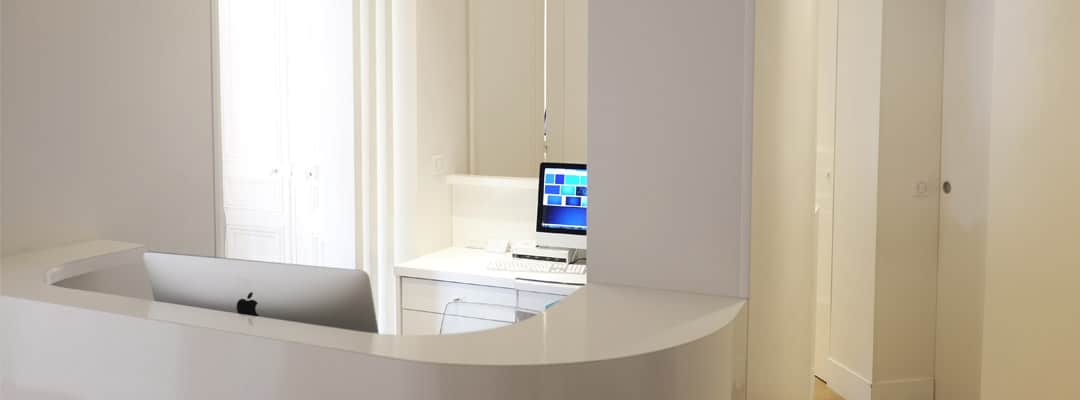
The First Consultation appointment
Dr. Issembert will first ask you what your reason for consultation is, as the treatment will vary depending on what the patient expects from his or her treatment. Then he will make a precise diagnosis, i.e. he will evaluate the situation. If, after this diagnosis, there is something that concerns him but that you did not verbalize at the time of your reason, he will then present it to you and explain it.
Example: You come in because you find that your teeth are not aligned. The diagnosis reveals that you also have teeth that are rather forward as well as lips, compared to a recessed chin. After presenting you with the diagnosis, you can tell us that you can indeed move your teeth back that you find too far forward. So, instead of just doing an in-place alignment treatment, we will suggest extracting two premolars up and two premolars down to achieve a significant recession of the teeth and lips. Some of you will tell us that this idea works for you and we will take it, and others will tell us that they do not like the idea of extracting teeth, in which case we will go back to the original complaint and align the teeth without extraction. Finally, the treatment plan is established and an appointment for impressions, photos and x-rays is scheduled. This can be done right after the consultation appointment.
The meeting of Empreintes, Photos and Radios
This is a 30-minute appointment during which we take a panoramic x-ray as well as a profile teleradiograph, photographs and impressions. This appointment lasts approximately 30 minutes, at a time of your choosing and sometimes even on the day of your consultation if you wish.
Laboratory Procedure
Dr. Issembert’s technician will cast the impressions and make two casts per arch. He will then put a separator on the casts and the doctor will position the braces on them. Then, the technician will create a transfer tray that will allow us to position the braces on the patient all at once.
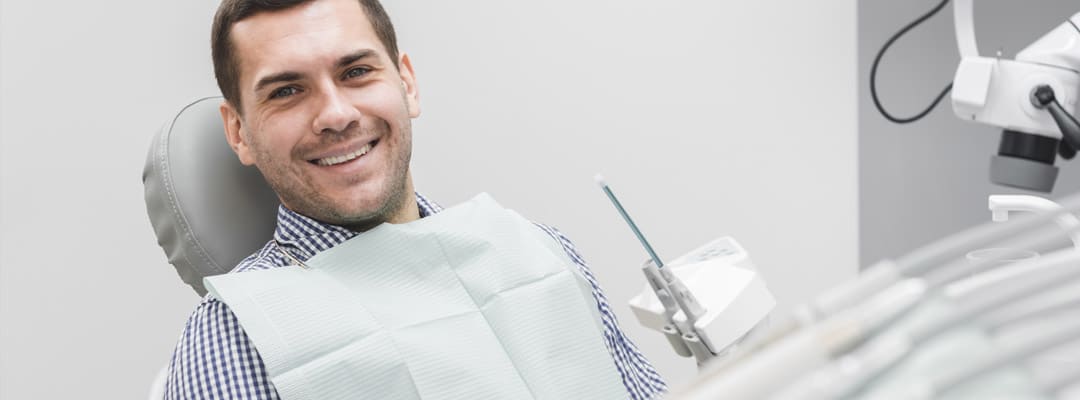
Fitting of ceramic rings
Between one and two weeks after the impression appointment, the braces are placed on your teeth using transfer trays. This procedure takes between one and a half and two hours. During this procedure, we will explain to you how the treatment works and the rules to follow to ensure that everything goes smoothly.
Treatment and finishes
As your treatment progresses, we schedule appointments at the office approximately every 4 to 8 weeks, depending on the treatment needs. During these appointments, a multitude of procedures can be performed: changing the sutures, placing invisible elastic chains, modifying the shape of the sutures, stripping… Once the result is obtained, at the end of the treatment, and in agreement with the patient, an appointment to remove the sutures and place the brace is scheduled.
Unstacking and double restraint
At the end of the treatment, a debulking appointment is held, followed by the placement of two wires at the top and bottom of the mouth, which will help keep your teeth in position over time. An impression is also made to produce the retainers.
Dr. Issembert attaches great importance to the durability of the treatment, and does everything possible from the beginning to ensure that there is no orthodontic recurrence. This involves a series of movements to be performed or avoided during treatment, as well as the use of a double retainer: a retainer wire glued to the back of the teeth from canine to canine at the top and bottom, and a safety splint.
The wire must remain in place for life, and for this reason the treatment plan must foresee its position from the start, so that the occlusion does not jeopardize its hold. In addition, the retention trays, which should be tried regularly in the evening, allow you to have a safety device to wear in case the wire breaks, while you return to the office to reposition the wire.
This double support is an essential guarantee of the good results of the treatment in the long term. In addition, we recommend that our patients try their aligners every night for a few seconds. Indeed, if the sensation is suddenly different from the previous nights, it may mean that the wire is damaged or broken, in which case it is advisable to wear the mouthpiece at night and make an appointment for us to refit it. On the day of the appointment, you will have to wear the trays at night and during the day until the appointment.
Ceramic By Issembert
for adults
Discretion
- It is a very discreet treatment, the braces and wires go unnoticed.
Comfort
- Once the braces are on, they do not require any particular maintenance. You just have to respect the authorized food and have a perfect dental hygiene.
Ceramics by Issembert for children and teenagers
The first visit to the orthodontist should take place between the ages of 6 and 7, when the first molars arrive on the arch. It is perfectly useless to intervene before that. Some parents benevolently say that the earlier you intervene, the less chance there is for a dental disorder to set in. This saying is only partially true.
Intervening before the teeth have grown in at age 6 only makes the child’s treatment take longer.
Interceptive orthodontics
This interceptive phase can have the following advantages:
- Avoid the development of problems that are much more difficult to deal with in adolescence
- Avoid tooth extraction or jaw surgery
- Allow for a much shorter treatment period in adolescence where they have less free time and social concerns take on more importance than before age 10
The 13 indications for interceptive treatment
Permanent molar blocked under a deciduous molar (risk of caries and risk of premature loss of the deciduous tooth which maintains the necessary space for the eruption of the permanent tooth).
Presence of a supernumerary tooth (its extraction allows a normal evolution of the tooth or teeth blocked in their eruption by its presence).
Dental agenesis (decide whether to remove the baby tooth or keep it on the arch according to the occlusion and the skeletal scheme).
Ankylosed baby tooth (its extraction at the time when the permanent tooth is mature enough to erupt allows a normal development of the dentition).
Digital suction (thumb or other finger) (its interruption at the time when the permanent incisors erupt allows a spontaneous correction of the gap and the deformation of the dental arch).
What are the recommendations for a ceramic treatment?
- Avoid spice-based foods (curry, turmeric), as they color not the bands but the rubber bands that hold the wire to the bottom of the bands. However, if the elastics were colored, you should not worry because at each appointment these foods are removed and replaced.
- Do not eat sticky or crunchy foods.
- Brush your teeth after each meal and ideally floss.
- Teeth may be sensitive to chewing for a week after the placement of the braces, but after three days this sensitivity decreases to disappear after a week. Do not hesitate to take paracetamol (Doliprane, Efferalgan…) in case of pain while respecting the indications written on the instructions. In case of doubt, it is essential to ask our advice or that of your pharmacist.
- At the beginning of the treatment, small irritations due to the friction of the braces on the lips may appear. You should not hesitate to apply orthodontic wax, which will be provided to you at the office, to the areas that are bothering you. This wax can be left in place during meals. There is no health risk if you accidentally swallow it. In general, after two weeks, the mucous membrane covering the cheeks and lips becomes more resistant and the wax is no longer necessary.



